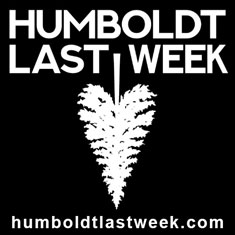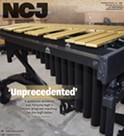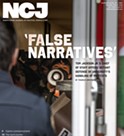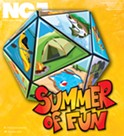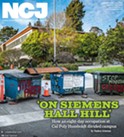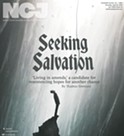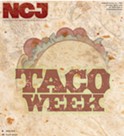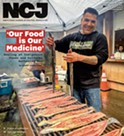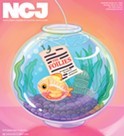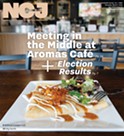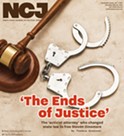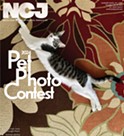Journalism at Three Arcata High Schools
Hope is a teen with a reporter's notebook, smart phone and a journalism class
By Deidre Pike[
{
"name": "Top Stories Video Pair",
"insertPoint": "7",
"component": "17087298",
"parentWrapperClass": "fdn-ads-inline-content-block",
"requiredCountToDisplay": "1"
}
]
The journalism adviser hands skinny reporter notebooks to students filing into her Arcata High School classroom. Today is a favorite day for English teacher Danielle Witten and her 30-person journalism class.
"It's the first day of our news cycle," Witten tells students, reminding reporters and editors of the importance of getting all student voices heard.
"There's nothing you can't write about," Witten says. "Except the illegal things we talked about last week."
Training for Arcata High's new editors and reporters for the student newspaper The Pepperbox included discussions of libel and privacy. Today, they'll brainstorm content for their first edition in October.
What will be on the cover of the first Pepperbox of fall semester? Perhaps the controversy over Arcata High teacher salaries and benefits. The paper's online coverage at www.thepepperbox.com by student editor Fiona Murphy has already gotten 256 views, the highest number ever for the nascent news site.
"The only people reporting this story are the students of Arcata High," Witten says. "Let's have a round of applause for Fiona."
Caledonia Davey, Pepperbox co-editor-in-chief, plans to pursue a career in news media.
"Journalism is something that will always be present," Davey says. "We'll always have journalists asking questions, holding leaders accountable and giving a voice to the voiceless."
Before her intro to the student press, Davey says she thought she wanted to be a veterinarian.
"I wanted to take care of my horses," she says. "Then I realized I want to do more to benefit other people, not just myself. That brings us to journalism."
Arcata High's Pepperbox is one of a handful of high school student publications on California's North Coast. McKinleyville High canceled its journalism class a decade ago and attempts to keep its student paper the Paw Prints alive via extracurricular club haven't been successful. Plans are in the works to distribute Arcata High's Pepperbox at McKinleyville High and invite its students to be correspondents.
Eureka High School hasn't had a journalism class for more than a decade. Attempts to publish the Eureka High Redwood Bark via a student club vary in success from year to year.
Eureka Mayor Susan Seaman, who worked in economic development but volunteered her time to serve as an advisor to the student newspaper, says she tried to keep the Bark going in the 2018-2019 school year. Because the paper's staff was a club that met during lunch – 20 minutes a week – students didn't manage to get a paper out.
"It breaks my heart," Seaman says. "I talked to them about how much power they'd have. How people do listen. But they didn't have the capacity. They were exhausted — each with 27 activities going on."
Would it help if the Bark were produced by a journalism class?
"Oh god, yes," Seaman says, adding that she'd even love to see a journalism class required for college admissions across the nation. That would cause interest in student media to surge. It would be great for students, too. Research commissioned by the Newspaper Association of America Foundation shows high school journalism students have higher grade point averages, do better on standardized tests and have higher success rates in college.
Seaman worked as a student editor at her Southern California high school and keeps in touch with her high school journalism adviser. One of Seaman's prized possessions is a letter from her high school principal. She can't remember the exact wording but the basic request was one familiar to newspaper editors: "Can you please just write nicer stories?"
The student press teaches writing, info gathering, verification, critical thinking and media literacy. Students investigate issues that interest them and tell true stories in print and online.
"It's one of the classes that's not a waste of time," says Caleb Weiss, a junior at Northcoast Preparatory Academy. He's been taking journalism classes and working on NPA's student publication the Heron Herald since his freshman year. "It gets me out in society, talking to people and learning things. This helps us grow as people. It's also really fun."
This year, Weiss and other students are creating Heron TV. The students completed studio training at Access Humboldt. They're shooting and editing footage for their first show to be aired in December on local cable and YouTube.
NPA history teacher Andrew Freeman advises the Herald, which comes out three times a year. High school journalism introduces students to the power of the press, he says.
"This is something concrete that they get to create," Freeman says. "I'm their adviser but this is theirs. They take ownership. A lot of high school is not like that."
High school journalists understand deadlines, Freeman says. They know why accuracy is important. They know that journalistic integrity matters.
"They all get that," he says. "They hold each other accountable."
The Herald holds editorial meetings in the Fireside Room at the United Methodist Church — NPA's high school campus on weekdays.
Seniors Autumn Wright and Omega Gaskill, co-editors of the Herald, are planning its first edition. Students sign up for stories from a long list of pitches on a shared Google drive.
An editor warns students not to sign up for a story about, say, a sports team that they are on.
"We want to avoid bias," she advises. "You can't write about the team if you're on it."
Wright was recruited onto the Herald team when someone visited her freshman class. When it came time for her first article, she was nervous about interviewing people.
"I'm not an outgoing person," she recalls thinking. "Why did I get myself into this? It didn't fit my personality."
Now Wright runs an editorial meeting with the confidence of a media pro.
"I've come out of myself," she says. "I've grown."
She asks good questions and expects thorough answers. She understands issues that impact students her age.
"Before journalism, I wasn't aware of what things were going on," she says. "Now I question things more. I understand news and news filters."
Wright did newspaper layout during her freshman and sophomore years. She loves using the software Adobe InDesign to put together words and images.
"But then I became editor," she says. "And you can't do everything, I realized."
Students of Six Rivers Charter School, located on the Arcata High campus, call themselves the Pirates.
On a weekday in September, Six Rivers' English teacher Meghan Froloff's journalism class meets to discuss a media agenda that ranges from the class "yarbook" to its website, Instagram and student newspaper The Swashbuckler. The Pirates do it all.
"What's news?" Froloff asks.
One idea: Someone at Arcata High has proposed a student walkout to support teacher salary negotiations. The proposal was written in Sharpie on a bathroom wall.
Davis Bell, a senior on the Pirate's breaking news team, says he can't find an event organizer or any further details.
Swashbuckler editor-in-chief Angel Barker says she did a quick Instagram poll and 14 students planned to walk out that day.
"We could write about student activism," a reporter suggests.
"We could write about the irony of it being on the bathroom wall," another chimes in.
"If there's a walkout, we'll cover it," Bell says. "If there isn't, we'll cover it."
"We think of ourselves as the Arcata Eye of high school publications," says Froloff, an HSU alumna with an English major and journalism minor. "We have a lot of out-of-the-box thinkers."
Editor's note: This story was updated from a previous version to correct an error regarding Susan Seaman's profession and to correctly attribute Caledonia Davey's quotes. The Journal regrets the errors.
Deidre Pike is the author of Media Literacy: Seeking Honesty, Independence and Productivity in Today's Mass Messages. Pike prefers she/her pronouns and is an associate professor of journalism at Humboldt State University. She was director of the Reynolds High School Journalism Institute from 2007-2014.
Speaking of...
more from the author
-
Poking Fun and Poking Holes
Why the world needs more parody news
- Oct 3, 2019
-
International Films, Humboldt Roots
Filmmaker Maria Matteoli
- Jul 15, 2018
-
Fake News
Russia, Disney and the toxic plague of information nihilism
- Jun 7, 2018
- More »
Latest in News
Readers also liked…
-
Through Mark Larson's Lens
A local photographer's favorite images of 2022 in Humboldt
- Jan 5, 2023
-
'To Celebrate Our Sovereignty'
Yurok Tribe to host gathering honoring 'ultimate river warrior' on the anniversary of the U.S. Supreme Court ruling that changed everything
- Jun 8, 2023
















